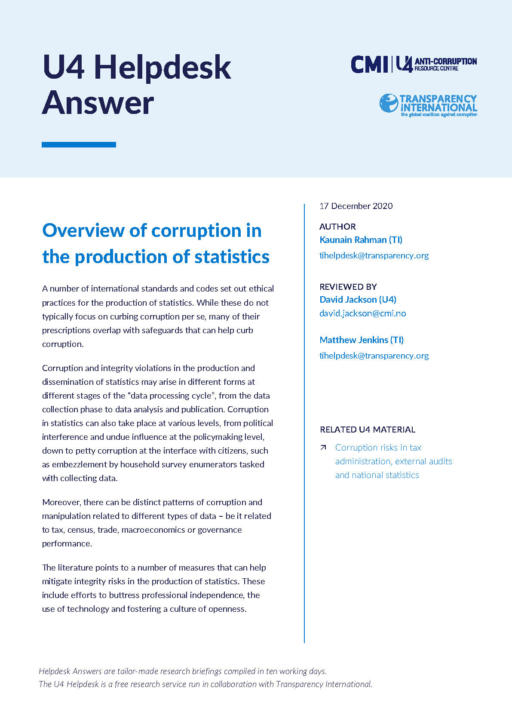
This Anti-Corruption Helpdesk brief was produced in response to a query from a U4 Partner Agency. The U4 Helpdesk is operated by Transparency International in collaboration with the U4 Anti-Corruption Resource Centre based at the Chr. Michelsen Institute.
Query
What are the main risks for corrupt practices in the area of statistics? How can these the risks be mitigated?
Summary
A number of international standards and codes set out ethical practices for the production of statistics. While these do not typically focus on curbing corruption per se, many of their prescriptions overlap with safeguards that can help curb corruption.
Corruption and integrity violations in the production and dissemination of statistics may arise in different forms at different stages of the “data processing cycle”, from the data collection phase to data analysis and publication. Corruption in statistics can also take place at various levels, from political interference and undue influence at the policymaking level, down to petty corruption at the interface with citizens, such as embezzlement by household survey enumerators tasked with collecting data.
Moreover, there can be distinct patterns of corruption and manipulation related to different types of data – be it related to tax, census, trade, macroeconomics or governance performance.
The literature points to a number of measures that can help mitigate integrity risks in the production of statistics. These include efforts to buttress professional independence, the use of technology and fostering a culture of openness.
Contents
- Background
- International statistical frameworks
- Corruption risks in statistical work
- Mitigation measures
- References
Main points
- While not specifically designed to tackle corruption, international standards intended to promote professionalism and high quality statistical outputs contain prescriptive provisions that can help promote integrity and minimise the risk of corruption in the production of statistics.
- Specific corruption risks may occur at different points of the data processing cycle. For example, bribery and bid rigging in procurement could be a risk at the data collection stage when the task is outsourced.
- A central concern for both the validity and integrity of statistical work is curbing political interference.
- Certain types of data may be particularly susceptible to corrupt manipulation, including macroeconomic, government performance and trade data.
Caveat
The extent and forms of corruption that can affect the work of statistical offices depend on a range of variables, including country context, sector, institutional structure and working practices.
Identifying an exhaustive list of corruption risks that could occur in various settings in which statistics are produced is thus not only beyond the scope of this Helpdesk Answer, but also relatively futile. Instead, this paper seeks to provide a framework to understand the various corruption risks that statistical processes may be exposed to and showcase several mitigation measures that could be applied to reduce vulnerabilities.
Authors
Kaunain Rahman (TI), [email protected]
Reviewers
David Jackson (U4), [email protected]
Matthew Jenkins (TI), [email protected]
Date
12/04/2021

